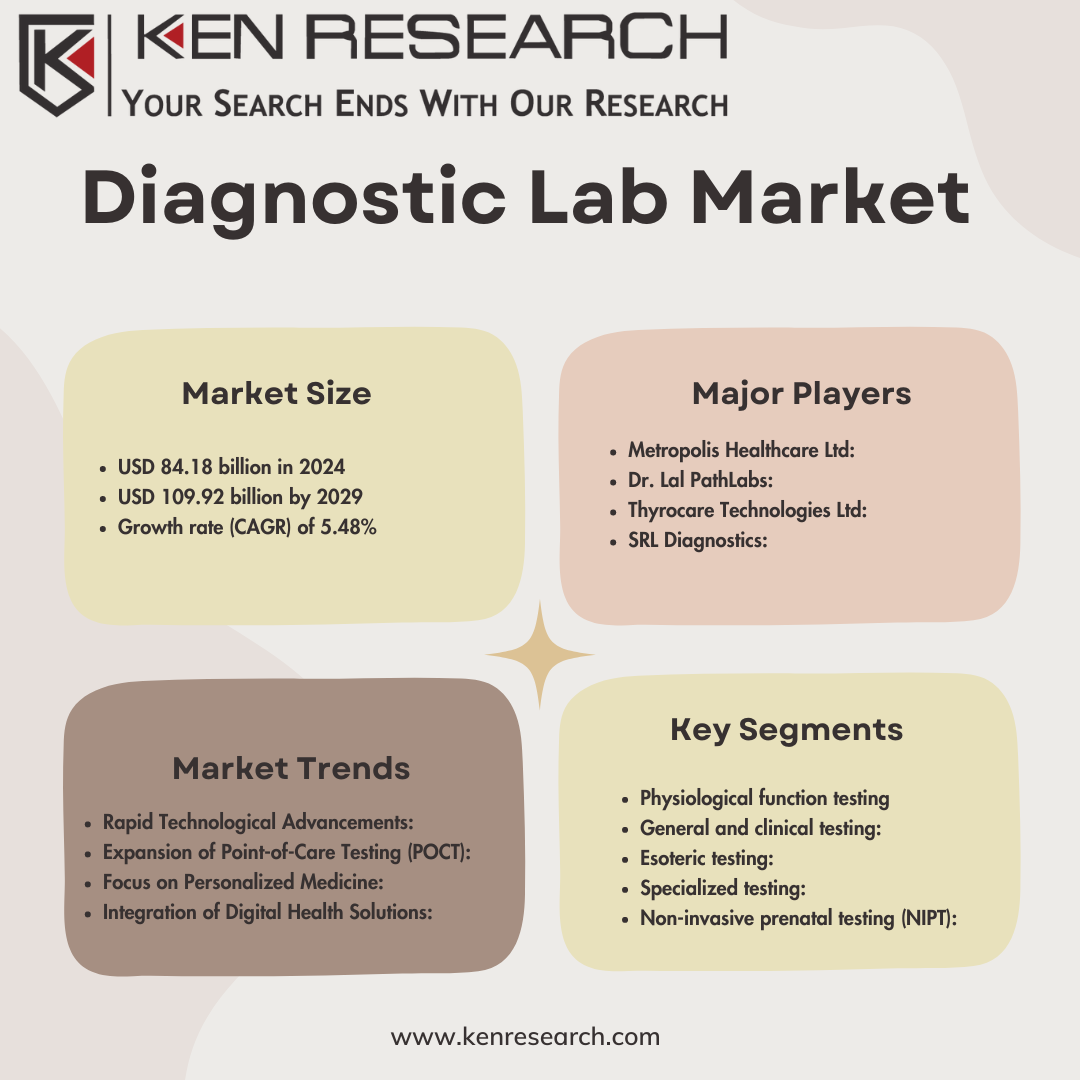Analysis Projection and Diagnostic Lab Market

The Diagnostic Lab Sector is experiencing significant growth, with projections indicating substantial expansion in the coming years. Valued at USD 84.18 billion in 2024, the market is expected to reach USD 109.92 billion by 2029, reflecting a robust compound annual growth rate (CAGR) of 5.48%.
Major Players In The Diagnostic Lab Market
The Diagnostic Lab Market Major Players include industry stalwarts such as
- Abbott Laboratories.
- Bio-Rad Laboratories Inc.
- Danaher Corporation
- Becton, Dickinson
- Qiagen
- Roche Diagnostics.
These players wield significant influence, shaping the competitive landscape through innovation and market presence.
Trends Shaping the Diagnostic Lab Sector
- Rise in Demand for Molecular Diagnostics: There is a growing demand for molecular diagnostic tests, driven by advancements in technology and their ability to provide precise and rapid results. Molecular diagnostics play a crucial role in identifying genetic markers, infectious diseases, and personalized treatment options, thereby enhancing patient care and outcomes.
- Expansion of Point-of-Care Testing (POCT): Point-of-care testing is gaining prominence due to its convenience, accessibility, and rapid turnaround time. With advancements in POCT devices and technologies, healthcare providers can perform diagnostic tests at the patient’s bedside, clinic, or remote locations, enabling timely diagnosis and treatment decisions.
- Integration of Artificial Intelligence (AI) and Data Analytics: The integration of AI and data analytics is revolutionizing diagnostic lab operations by streamlining workflow, improving accuracy, and optimizing resource utilization. AI-powered algorithms can analyze vast amounts of diagnostic data, identify patterns, and assist healthcare professionals in making informed diagnostic and prognostic decisions.
- Shift Towards Telemedicine and Remote Diagnostics: Telemedicine and remote diagnostics are becoming increasingly prevalent, especially in the wake of the COVID-19 pandemic. Remote diagnostic services allow patients to undergo diagnostic tests from the comfort of their homes, minimizing the need for physical clinic visits and reducing healthcare-associated risks.
- Focus on Preventive Healthcare and Wellness Testing: There is a growing emphasis on preventive healthcare and wellness testing, driven by increasing awareness of the importance of early disease detection and proactive health management. Diagnostic lab are offering comprehensive wellness panels and preventive screening tests to assess overall health status and identify potential health risks before symptoms manifest.
Regional Analysis of the Diagnostic Lab Market
North America emerges as a dominant force in the diagnostic lab industry, driven by factors such as an aging population, heightened disease awareness, and a high prevalence of infectious and chronic diseases. The region’s robust healthcare infrastructure and research funding further cement its market dominance.
Competitive Landscape of the Diagnostic Lab Sector
The diagnostic lab sector is characterized by intense competition and a diverse array of players offering a wide range of diagnostic services and solutions.
- Global Diagnostic Lab Chains: Major multinational diagnostic lab chains dominate the global market, leveraging their extensive network of laboratories, advanced technology platforms, and comprehensive test menus. Companies such as Quest Diagnostics, LabCorp, Sonic Healthcare, and Eurofins Scientific are prominent players with a strong presence across multiple geographies.
- Regional and National Players: In addition to global chains, the diagnostic lab market comprises numerous regional and national players operating in specific countries or regions. These companies cater to local healthcare needs, offer specialized testing services, and often have established relationships with healthcare providers, insurers, and government agencies.
- Hospital-based Laboratories: Many hospitals and healthcare institutions have their diagnostic laboratories, providing a wide range of testing services to support patient care and medical treatment. These hospital-based lab vary in size and scope, ranging from small clinics offering basic tests to large academic medical centers with advanced diagnostic capabilities.
- Independent Reference Laboratories: Independent reference laboratories play a crucial role in the diagnostic ecosystem, offering specialized testing services, esoteric assays, and niche diagnostic panels that may not be available in mainstream labs. These laboratories focus on specific areas such as genetics, molecular diagnostics, or specialized testing for rare diseases.
- Specialty Diagnostic Providers: Some diagnostic labs specialize in particular areas of healthcare, such as oncology, cardiovascular diagnostics, women’s health, or infectious diseases. These specialty providers offer advanced testing services, innovative diagnostic technologies, and expertise in specific medical disciplines.
Key Segments Covered
Revenue segmentation by government and private lab, pathology and radiology, pathology types, radiology types, and business models offers insights into the diverse facets of the diagnostic lab market, catering to varied healthcare requirements.
Key Target Audience
- Government and private diagnostic lab
- Research lab
- Medical insurance companies
- Medical device manufacturers
- Industry associations
- Government bodies
Investors/VCs constitute the key stakeholders shaping the diagnostic lab landscape.
Conclusion
The Diagnostic Lab market is experiencing robust growth, driven by factors such as increased disease prevalence, technological innovation, and rising healthcare awareness. With key players driving innovation and advancements, the future of clinical diagnostics looks promising, with a focus on improving disease detection and management.
FAQs
Q.1 What factors are driving the growth of the Diagnostic lab Sector?
Ans. The growth is primarily driven by increasing disease prevalence, technological advancements, and rising healthcare awareness.
Q.2 Which regions are expected to dominate the clinical diagnostics market?
Ans. North America is anticipated to dominate the market, fueled by factors such as an aging population and a high prevalence of chronic diseases.
Q.3 What role do lipid panel tests play in clinical diagnostics?
Ans. Lipid panel tests are crucial for assessing cardiovascular risk and early disease detection, especially in the context of rising cardiovascular disease prevalence globally.
Q.4 Who are the major players in the Diagnostic lab Industry?
Ans. Key players include Abbott Laboratories, Bio-Rad Laboratories Inc., Danaher Corporation, and Roche Diagnostics, among others.
Q.5 What is the future outlook for the clinical diagnostics market?
Ans. The market is poised for continued growth, driven by technological advancements, increasing disease burden, and healthcare infrastructure development.


